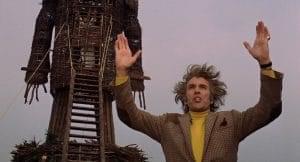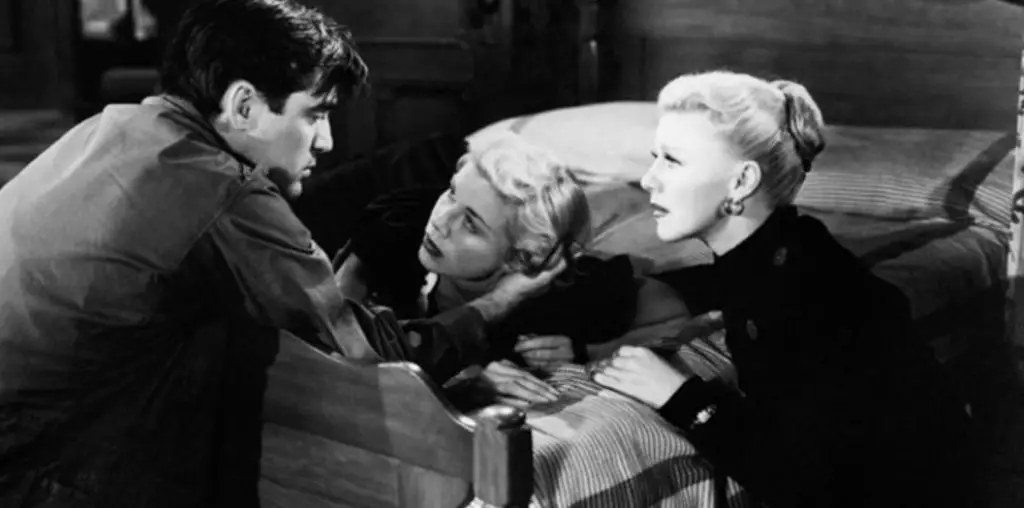
Each offbeat flop and limited release comes with the caveat that, a few years down the line, it could achieve cult status. But how many of these films are actually about cults? It turns out a healthy chunk of them are. This could be because of the naturally eccentric nature of living in a cult. The isolation allows fringe beliefs and strange rituals to proliferate, so it would stand to reason that films about these groups would dip into weird, surreal territory.
Often, filmic cults exist in communities that are geographically apart. Islands. Forests. Small, rural parishes. Or the characters are marginalized in other ways: they are sideshow performers or modern pagans or elderly loners. Sure, there are plenty of ways to wrangle a unique film without staging occult rituals in the backwoods, but the cults as presented here want the same thing as the audience watching them: to be diverted from the mainstream and led down creepy, winding, unpopular tributaries.

5. The Wicker Man (1973)
The Wicker Man follows Sergeant Howie as he investigates a missing girl on a remote Scottish island village called Summerisle. Howie becomes convinced the pagan beliefs held by the island dwellers connect to the girl’s disappearance. The first act of the film feels surprisingly upbeat, and devoid of horror, as we explore the pastoral farming community. In fact, The Wicker Man could qualify as a musical considering the number of folk ballads belted as the cultists weave a Maypole, dance in a Stonehenge-type structure, and burn the titular Wicker Man. However, the songs are laced with hidden, and overt, nods to pagan beliefs around sex, death, and rebirth.
As cults go, Summerisle actually doesn’t seem too bad. Sure, the cultists eventually dawn animal masks and commit human sacrifice to make their crops grow, but the Scottish countryside is undeniably beautiful, and Christopher Lee’s Lord Summerisle makes for a charming leader. But Howie, a staunch Christian, quickly finds himself at odds with nearly every inhabitant of the town. He is disturbed by the pagan teachings being instilled in the school children, as well as the islanders’ open attitudes towards sex and nudity. At its core, The Wicker Man depicts the clash between Christianity and the older pagan beliefs it supplanted.
The Wicker Man stands as a seminal piece of folk horror. It eschews gore and focuses on creating a weird tone and a community where everybody seems slightly off. Director Robin Hardy and screenwriter Anthony Shaffer make simple things like rabbits, masks, and toads frightening. The plot consists of a fairly simple pound-the-pavement detective story, which makes the final twist clear-cut and impactful.

4. The Wicker Man (2006)
Neil LaBute’s 2006 remake of The Wicker Man achieved cult status for different reasons than its predecessor. Whereas the 1973 Wicker Man was a tonally consistent, haunting trip to a pagan island, the 2006 remake is known for “Not the bees!” and the sight of Nicholas Cage running around in a bear suit while clocking women in the face. There’s the scene where Cage commandeers a bicycle with narcoleptic intensity. Or the classroom sequence where Cage accuses the ten-year-olds of being “little liars.” To be fair, a similar scene takes place in the original film, but Cage’s performance, coupled with the retooling of the scene, heightens the absurdity.
The neo-pagan community in this iteration turns the men on the island into nonverbal zombies. The film has something to say about gender, but any commentary is drowned out by dream sequences within dream sequences (before Inception), Ellen Bursten in Braveheart face paint, and creepy phone calls – on an island without phones! You’ll end up laughing manically with Cage as the classroom of students recites, “Phallic symbol, phallic symbol,” in dead-eyed unison. Cage plays the character with constant befuddlement and fuming exasperation, which actually makes him the most relatable person on the island.
The Wicker Man echoes the M. Night Shyamalan movies of the early 2000s (particularly The Village) with its kooky turns by well-respected actors, (here’s looking at you, Ellen Burstyn and Adrien Brody) mixed with streaks of bizarre creativity. It’s often boring, but each tedious stretch ends with a burst of absurdity that makes the wait worth it. Denigrate its effectiveness as a horror movie all you like, but The Wicker Man remake creates just as weird an atmosphere as its predecessor.

3. Santa Sangre (1989)
When a circus performer breaks out of the mental hospital holding him, he joins his armless mother, who is the leader of a bizarre religious cult, and murders women at her behest. Directed by Alejandro Jodorowsky (El Topo, The Holy Mountain, and almost Dune) Santa Sangre straddles the fence between camp slasher and surreal arthouse. From a grand elephant burial, to a dream sequence where hundreds of hens rain down from the sky, Jodorowsky packs the film with memorable visuals that disturb and fascinate – though I can’t vouch for the film’s animal treatment credentials.
The cult at the center of the film worships the effigy of a young girl whose hands were cut off after she was raped. In one of the early sequences, a landowner bulldozes the cult’s church after a Catholic Monsignor declares it blasphemous. From there, the plot spins into a maddening, semi-narrative that seamlessly meshes hallucination and reality. All of the violence is stylized (gallons of red paint were spilled for this movie) and sexualized, with multiple knife throwing sequences and a mother-son relationship that rivals Psycho.

2. The Blood on Satan’s Claw (1971)
When a farmer plowing his field discovers an inhuman skull, a mass hysteria sweeps the towns and surrounding countryside of 17th century England. People begin to grow claws and hair in the wrong places. And a cult of children worships an inhuman entity they dub “The Behemoth.”
The Blood on Satan’s Claw feels immutably 70s, but it still creates an eerie tone due in large part to the nervy, lilting score by Marc Wilkinson, coupled with Linda Hayden’s solid performance as the ironically-named cult leader Angel Blake, who seems simultaneously childish and psychopathic. Angel leads the other children of the parish in games beginning as innocent pranks and ending in far more sinister ways. In one of these sequences, a group of girls plays with a blindfolded boy, leading him to a shed where he is murdered. The film is particularly effective at blurring lines between play and sadism as pranks turn serious and ragtag rituals end up summoning a real monster.
As with most slow-burn horror, the satanic entity is far scarier as a distant, ominous figure operating via the children’s cult. Once it is revealed and confronted in the flesh, it looks like a cross between a vampire bat and a Wookie by way of a bad furry suit. Regardless of its budgetary trappings, The Blood on Satan’s Claw distinguishes itself as an atmospheric, strange slice of British folk horror. It leaves the lasting impression that any tumbled down stonewall or overgrown piece of farmland might conceal a hidden devil skull waiting to be dug up and worshipped back to life.

1. Rosemary’s Baby (1968)
Rosemary’s Baby takes the cult out of the backwoods and into an upscale New York apartment building. The mundane scenes populating the front half of the film lend the occult elements insidious feasibility. Rosemary and her husband Guy move into their new apartment, meet the elderly tenants, and Guy auditions for roles as an actor. After a disturbing psychedelic sequence, in which a demon rapes Rosemary while her husband and the other tenants watch, Rosemary discovers she is pregnant. While Guy assures Rosemary her experience was a hallucination, it turns out to be a pretty accurate recollection of events as the film creeps towards its inevitable conclusion.
We find out Rosemary’s husband has made a Faustian deal by proxy in order to further his acting career. He and the coven of other tenants conspired to force Rosemary to bear the son of Satan. The monster at the heart of Rosemary’s Baby remains obscure, however, the cultists make up for the lack of creature-feature antics. Ruth Gordon’s Oscar-winning turn as Minnie Castevet strikes a compelling balance between waspy affection and malevolent zeal. Mia Farrow also completely sells every scene, including one where Rosemary wanders into traffic – which Farrow did without the benefit of closed off roads and stunt drivers. The sixties were a different time.
The influence of Rosemary’s Baby surfaces in recent releases like Mother! and Hereditary. The memorable final shot ties the film up in a tangled knot that allows for the imagination to run wild and leaves the viewer with the unsettling question of what happens next. If it came out today, it would reliably spawn a bevy of ‘ending explained’ videos on opening weekend.




[…] themes from zombies and supernatural, to slasher and psychological horror. There has also been many popular films that have focused on cults, such as Rosemary’s Baby (1968) and The Wicker Man (1973). However, with more recent films, the […]